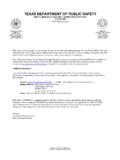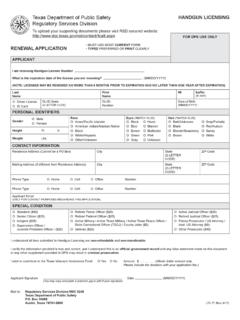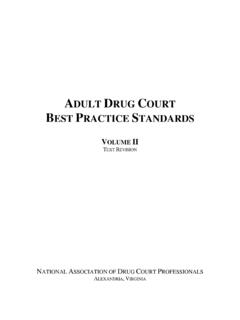Transcription of NCIC 2000 INTRODUCTION
1 NCIC 2000. INTRODUCTION . SECTION 1--WHAT IS NCIC 2000? DEFINITION. 1. The National crime Information Center (NCIC) 2000 is the System replacing the NCIC System. NCIC 2000 has the same mission and the same basic functionality as NCIC, but also features new capabilities which are described in this operating manual. Just as NCIC, NCIC 2000 is a nationwide, computerized information system established as a service to all criminal justice agencies--local, state, and federal. The goal of NCIC 2000 is to help the criminal justice community perform its duties by providing and maintaining a computerized filing system of accurate and timely documented criminal justice information. For NCIC 2000 purposes, criminal justice information is defined as "information collected by criminal justice agencies that is needed for the performance of their legally authorized, required function.
2 This includes wanted person information; missing person information; unidentified person information; stolen property information;. criminal history information; information compiled in the course of investigation of crimes that are known or believed on reasonable grounds to have occurred, including information on identifiable individuals; and information on identifiable individuals compiled in an effort to anticipate, prevent, or monitor possible criminal activity." The NCIC 2000 data bank can best be described as a computerized index of documented criminal justice information concerning crimes and criminals of nationwide interest and a locator file for missing and unidentified persons.
3 2. The structure and basic procedures of the NCIC System were approved by resolution of the full membership of the International association of Chiefs of Police in Philadelphia, Pennsylvania, in October 1966 and apply to the new NCIC 2000 System. General policy concerning the philosophy, concept, and operational principles of the System is based upon the recommendations of the Criminal Justice Information Services (CJIS) Advisory Policy Board (APB) to the Director of the FBI. The APB is comprised of top administrators from local, state, and federal criminal justice agencies throughout the United States. Through the APB, its Subcommittee and Working Group input, changes in current applications, the addition of new files, and new procedures, , edits, codes, validations, are coordinated with all NCIC and NCIC 2000.
4 Participants. 3. The NCIC 2000 System stores vast amounts of criminal justice information which can be instantly retrieved by and/or furnished to any authorized agency. 4. The NCIC 2000 System serves criminal justice agencies in the 50 states, the District of Columbia, Puerto Rico, and Canada. Through established state systems, the NCIC 2000 System has become available for use by all criminal justice agencies. Access to the NCIC 2000 Vehicle, Boat, Vehicle/Boat Part, and License Plate Files by specific foreign nations is provided through INTERPOL. Technical Contractor Employee Certification Reference Documentation: Excerpts from NCIC Operating Manual 1. DATA AND PROBABLE CAUSE. 1. An NCIC 2000 hit alone is not probable cause to arrest, but indicates that a stolen property report, missing person report, or warrant, etc.
5 May have been filed. A hit is only one element comprising sufficient legal grounds for probable cause to arrest. 2. Correct NCIC 2000 procedure requires the agency which placed the record in file be contacted by the inquiring agency to confirm that the data are accurate and up-to- date. In some circumstances, the hit confirmed with the originating agency may be the major or only element necessary to detain or make an arrest. For instance, a confirmation of an outstanding warrant on an individual or a hit confirmed on a stolen vehicle or stolen property in a timeframe very close to the time of an actual theft would likely support an arrest decision. The confirmation of a hit on a person file record, regardless of how long it had been in the System, would be enough cause to take appropriate action.
6 However, when attempting to recover the stolen property record that had been in the System one or two years, the officer would need not only the element of the hit but also additional facts adding up to probable cause. For instance, a hit on a record two years after a vehicle was stolen would in itself be inadequate probable cause for an arrest, since it would be possible or even probable the vehicle was then in the possession of an innocent purchaser rather than the original thief. To make an arrest under these circumstances, the officer would need not only the element of the hit but also additional facts adding up to probable cause. A. hit confirmed with the originating agency can be adequate grounds to recover stolen property, return a missing person, arrest a fugitive, or charge a subject with violation of a protection order.
7 3. Files, such as the Violent Gang and Terrorist Organization, Convicted Person on Supervised Release, Convicted Sexual Offender Registry, Protection Order, and US Secret Service Protective, do not require hit confirmation and are designed to provide law enforcement officers with adequate warning regarding individuals who have had involvement in criminal activities or are known to represent potential danger to the public. RESPONSIBILITY FOR RECORDS. 1. NCIC 2000 records must be kept accurate and up-to-date. Agencies that enter records in the NCIC 2000 System are responsible for their accuracy, timeliness, and completeness. To facilitate compliance with hit confirmation requirements, the originating agency must be available 24 hours a day to confirm its record entries.
8 Nonterminal agencies must sign a "Holder of the Record" agreement with a 24-hour agency delineating the responsibility for hit confirmation. Originating agencies that are not available 24 hours must place instructions for after-hour hit confirmation, a 24-hour contact telephone number or an Originating Agency Identifier (ORI) in the Miscellaneous Field. 2. Stringent administrative procedures and controls to ensure that accurate data are entered in computerized criminal justice information systems are important. An officer's evaluation of the information contained in a hit Technical Contractor Employee Certification Reference Documentation: Excerpts from NCIC Operating Manual 2. response is just as important as keeping the information accurate, timely, and complete.
9 Combining stringent administrative controls with proper evaluation by the officer receiving the hit can prevent lost court cases, civil liability suits, false arrests, and criminal charges against the law enforcement officer. 3. The FBI, as manager of the NCIC 2000 System, helps maintain the integrity of the System through: 1. Automatic computer edits which reject records with certain common types of errors in data;. 2. Automatic purging of records after they are on file for a prescribed period of time;. 3. Quality control checks by FBI personnel; and, 4. Distribution of records to be validated. (Details concerning quality control and validation procedures appear in Section 3 of this INTRODUCTION .)
10 4. The NCIC 2000 System makes centralized crime data immediately available to the criminal justice community. The success of the System depends upon the extent to which patrol officers, investigators, judges, prosecutors, corrections officers, and other criminal justice agency officials intelligently use it in day-to-day operations. 5. This manual contains instructions designed to guide participants in using the NCIC 2000 System. No system can be expected to produce results unless it is properly used. The standards and procedures set forth should be strictly followed as every exception tends to degrade the System and the integrity of the data stored in the System. 6. All inquiries regarding the NCIC 2000 System should be addressed to the FBI, CJIS Division, Attention: NCIC 2000, Module E-3, 1000 Custer Hollow Road, Clarksburg, West Virginia 26306-0153.












